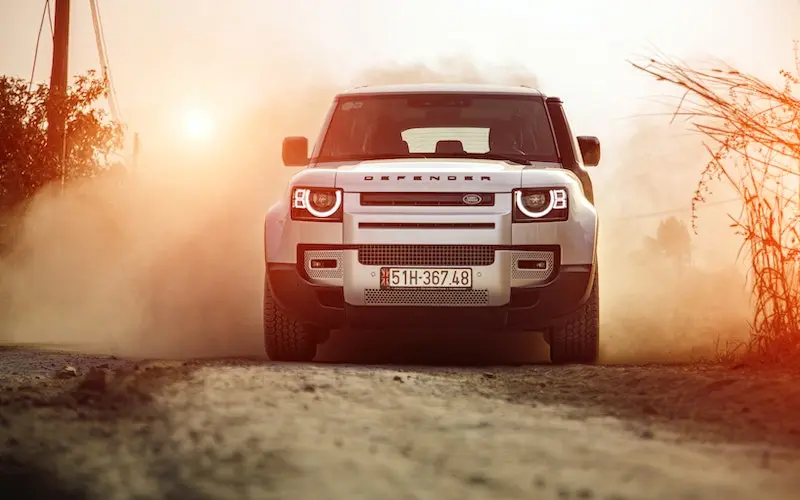The Land Rover Defender is one of the most iconic and recognizable SUVs in the world. Known for its boxy profile and off-road prowess, the Defender has been a mainstay of rugged British utility for 70+ years.
But what exactly is the Defender and what key qualities define this legendary 4×4? Let’s explore What kind of Vehicle is the Land Rover Defender, the origins and essential traits of the classic Defender.
The History of the Land Rover Defender
The Defender traces its roots back to the original Land Rover Series I introduced at the 1948 Amsterdam Auto Show. This utilitarian 4×4 was meant to provide rugged mobility in postwar Britain.
The Series I evolved into the Series II and Series III models during the 1960s-70s, improving on the no-frills design but retaining hardcore off-road capabilities. These early Land Rovers formed the foundation of the eventual Defender line.
In 1983, Land Rover introduced the model name Defender alongside a redesigned Series III variant. This more powerful Defender featured modern amenities like more comfortable seating and an available 90 hp diesel engine. An icon was born.
The Defender’s Distinct Body Styles
Two distinct body styles make up the Defender range:
90 – Short wheelbase model seating up to six. Features classic Land Rover box shape. Offers maximum maneuverability and breakover angle for trails. Available with soft or hard top.
110 – Long wheelbase variant adds rear cargo area. Seats up to nine passengers with a full frame structure. Ideal for mixing cargo and passenger duties. Also comes in pickup truck variation.
These two durable, straightforward models cater to both work and family duties while carrying the Defender nameplate.
Key Mechanical Specs and Capabilities
As a traditional body-on-frame SUV, the Defender delivers proven truck-derived capability:
- Body-on-frame construction for rugged durability
- Coil spring or traditional leaf spring suspensions
- Part-time four-wheel drive standard
- Low range gearing and differential locks for off-road terrain
- Short front and rear overhangs enhance approach/departure angles
- High ground clearance (up to 14 inches) for water fording
- Powerful inline turbo diesel engines mated to 5- or 6-speed manuals
These mechanicals allow the Defender to traverse rough landscapes well beyond what typical crossovers could handle. Its straightforward design ensures robustness over comfort.
Defender Interior and Creature Comforts
The Defender retains its agricultural roots through a basic, functional interior:
- Durable rubber floors with floor drain plugs
- Water resistant and easily cleaned interior surfaces
- Fold-down jump seats or optional third row bench
- Optional heaters and air conditioning
- Digital radio compatible with roof speakers
- Center-mounted gear lever and handbrake
- Multiple 12v accessory sockets
There are few frills inside, with focus instead on capability, ease of cleaning and occupant/cargo practicality. More recent models add some insulation for improved refinement.
The Defender’s Cultural Significance
As one of Britain’s most identifiable vehicles, the Defender gained cultural significance beyond just rugged transportation:
- Starred in movies and TV like Jurassic Park for its capability and familiar shape
- Served with police and military groups in roles like patrolling, communications and ITV
- Became a status symbol in upscale neighborhoods around the world
- Often customized with unique paint colors, wheels and accessories
- Represents old-school SUV adventuring compared to modern unibody crossovers
For many worldwide, the Defender’s boxy profile instantly conjures images of quintessential British automotive grit and charm.
Why the Defender Was Discontinued in 2016
After nearly 70 years of production, Land Rover ended manufacture of the Defender in 2016. Reasons included:
- Stricter crash/emissions regulations made the old body-on-frame design unfeasible
- Couldn’t accommodate modern features and powertrains
- Sales remained modest compared to popular crossovers like the Range Rover Evoque
- Investment required for redesign could not be justified by low demand
While iconic, the ancient Defender had simply reached the end of its viable production life in original form. A 21st century reimagining would be required.
The Return of the Defender in 2020
After a four year absence, Land Rover revived the Defender nameplate for 2020 on an all-new unibody SUV. This contemporary Defender retains classic styling cues like:
- Boxy profile with short front and rear overhangs
- Alpine roof windows for enhanced visibility
- Minimal exterior ornamentation and badges
- Large knobby tires and increased ride height
But the new Defender moves to modern monocoque construction for better comfort and refinement. Advanced off-road tech and turbocharged powertrains bring performance into the 21st century. It continues the Defender heritage while moving with the times.
Conclusion
For over 70 years across multiple generations, the Land Rover Defender has proudly upheld its heritage of rugged British-built 4×4 capability. With its straightforward, boxy silhouette and renowned durability, the iconic Defender represents off-road readiness above all else.
While the basicDefender has evolved into a thoroughly modern SUV, it remains one of the world’s instantly recognizable shapes symbolizing adventure and resilience. The Defender’s just-right balance of form and function continues to power this 4×4 stalwart into the future.
